Three years after starting up our Oregon farm, my husband, Casey, and I decided it was time to grow our farm family. In April 2009, I found out I was pregnant with our first child. Looking at the pregnancy test double lines felt like the start of a whole new adventure in our farming life, one that would require me to carry almost all of the physical burden of the pregnancy while together we operated our farm.
In that moment, I had some idea of what could happen in the subsequent months, but pregnancy is by its nature individual and varied, often full of surprises and unexpected twists. As a self-employed person with a very physical job, I had the added question of how the pregnancy would affect my ability to work on our farm and provide our livelihood.
To help prepare for the inevitable changes, we hired our first employees and built in as much flexibility as we could into our expectations. That pregnancy went about as normally as one might imagine: plenty of early pregnancy nausea, fatigue, lots of wonder and joy, round-ligament pain, some insomnia, anticipation and trepidation, and finally a healthy birth on the farm, just days after our final December harvest.
But even a relatively straightforward pregnancy created some hiccups, such as when a heat wave left me feeling too overheated and ill to go to a CSA pick-up — the first I’d ever missed. That’s where flexibility was important.
Accommodating pregnancy
The experience of a pregnancy on the farm is something that many operations go through at some point — whether it’s the pregnancy of an owner, a spouse/partner, or an employee. For the health of the farm and pregnant farmer both, it’s essential everyone understand that pregnancy may bring changes to everything and be thinking early on about accommodations in practices and expectations.
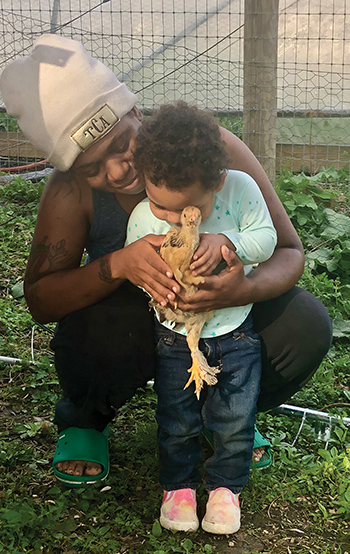 Turquoise Connelly is expecting their second child while also parenting a toddler, running a small farm, and working off-farm. Connelly reports feeling like they are actually getting more done with the presence of their young child: “Having my almost two-year old with me is energizing and provides me teaching and bonding opportunities.”
Turquoise Connelly is expecting their second child while also parenting a toddler, running a small farm, and working off-farm. Connelly reports feeling like they are actually getting more done with the presence of their young child: “Having my almost two-year old with me is energizing and provides me teaching and bonding opportunities.”
That being said, every pregnancy is unique, and no one should make assumptions that experiences will be smooth or hard. At the beginning of a farming pregnancy experience, awareness and openness are more important than assumptions.
In this article (and an upcoming article on birth and postpartum healing), my goal is to highlight experiences and aspects of pregnancy that a farmer will want to keep in mind. While researching, I heard from 60 farmers from around the world who have been through pregnancy while farming. Their contributions helped me see trends even amongst the incredibly unique and personal experiences. My hope is that these real-world accounts will help other farmers prepare for their own positive pregnancy experiences.
Timing a pregnancy … or not!
Farming is seasonal work: there are times with more work and times with less work. Generally speaking, farmers plan for these rhythms of life both consciously and unconsciously.
For our first baby, Casey and I decided that we would like to make the transition to parenthood in winter, our slowest season, when we’d have the most easeful time to rest and bond with our baby. That plan actually worked, and I went into labor the night after our final CSA pick-up of the year.
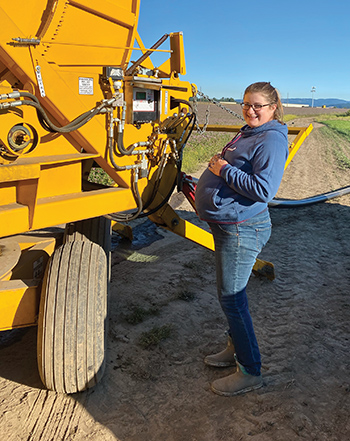 Anne Marie Boyd was still moving irrigation nine days before she delivered her son. “I did have a crew with me to assist with some moving of pipes that were full of water though. They followed me around like hawks whenever I was on the farm during the last trimester; they were always so worried about me.”
Anne Marie Boyd was still moving irrigation nine days before she delivered her son. “I did have a crew with me to assist with some moving of pipes that were full of water though. They followed me around like hawks whenever I was on the farm during the last trimester; they were always so worried about me.”
Many other farmers also have planned their pregnancy so that birth would happen near the end of their main work season, giving them a few quiet weeks or months of adjustment. The farmers for whom this plan worked were grateful for the timing and the space it provided.
However, just as many farmers said that timing didn’t work because of the unpredictable nature of conception. Some had to deal with infertility or miscarriages, shifting the eventual due dates. Some pregnancies were simply surprises. And, other farmers felt that having a baby was too big of a life event to try to dictate in the same way they approach crop planning. They felt more comfortable leaving it open.
Vanessa Briesch of Lilybet Farm in New Jersey said, “Pregnancy is unpredictable. I didn’t want to wait for the ‘right time’ only to not get pregnant and add a lot of stress which would be counterproductive anyway.”
Early pregnancy challenges
Once pregnancy begins, the common early complaints are no surprise to anyone who’s been pregnant: nausea and fatigue. Melissa Streng of Sun Love Farm in Oregon experienced both. “Harvesting a bed of tomatoes is ten times more exhausting when the smell of them makes you want to vomit,” she said. “Being pregnant and farming is incredibly physically exhausting.” Melissa worked through the challenge by going to bed by 8 p.m. most nights.
Not every farmer reported these early pregnancy challenges, but those who did said that resting when they could, making sure to eat what they could, and asking for help were essential.
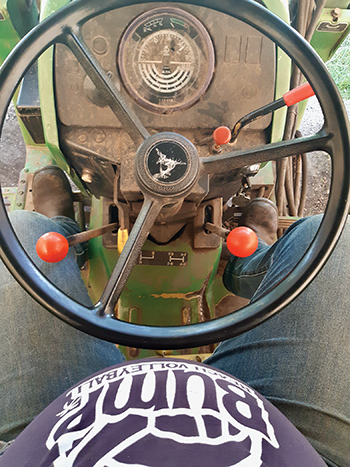
Mel Sylvestre could still (barely!) drive the tractor at 32-weeks pregnant with twins. “The twins had started to move at that point, and I used to joke that they would bonk their head on the steering wheel!” She couldn’t fit behind the wheel soon after this.
Hannah Wittwer works at Shalom Farms in Virginia, and she experienced extreme nausea in her first trimester and had the added challenge that she wasn’t ready to tell the whole farm about her pregnancy yet. She told one coworker about the pregnancy from the beginning and even just having that support was helpful: “We had a code phrase to use over the walkie in case I needed pregnancy related help (‘Has anyone seen my pruners?’) and even just knowing that I could ask for help made me feel better.”
Of course, sometimes the notion of “help” can actually be a problem for the pregnant farmer. Many farmers reported that as coworkers and customers learned of their pregnancy, other people wanted to “help” or limit the pregnant farmer’s work beyond what was actually necessary.
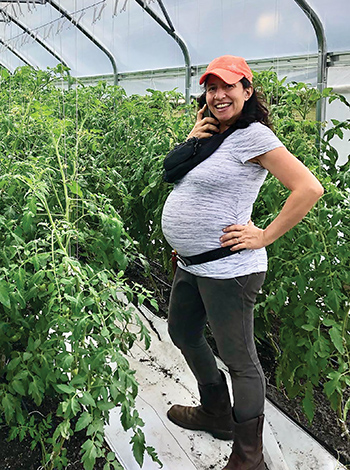 At 31-weeks pregnant, Ellen Turner visited Little Pond Farm’s cherry tomato greenhouse to put out beneficial wasps. She was able to keep working until the end of pregnancy, “although I did delegate most of my field work to the crew in preparation for caring for a newborn, so that started in the third trimester.”
At 31-weeks pregnant, Ellen Turner visited Little Pond Farm’s cherry tomato greenhouse to put out beneficial wasps. She was able to keep working until the end of pregnancy, “although I did delegate most of my field work to the crew in preparation for caring for a newborn, so that started in the third trimester.”
Anne Marie Boyd of Motz & Son Nursery in Oregon said one of the most challenging parts of her pregnancy was the way her employees treated her. “My employees were very much uncomfortable with me doing my normal duties around the farm, I think they saw me as a walking potential bomb,” she said. They didn’t want her to operate machinery or help move irrigation lines. “It was sweet but frustrating because I knew that I was still capable of doing those things.”
What to wear?
Further into pregnancy, most farmers had to find new clothes to fit their changing bodies. Some farmers reported big challenges with limited options for maternity work clothing. Also, some farmers pointed out that maternity specific clothing can be expensive and is often only worn for a few months — an investment that stretched their budgets. However, almost everyone reported finding clothing that worked even if they were frustrated by lack of options.
Many farmers said overalls work by unbuttoning the side buttons as needed. If those stopped working, they acquired maternity-specific overalls — that’s what I wore during my pregnancies while working. Dovetail Workwear makes a maternity jean that worked for some farmers. Tara Chapman of Two Hives Honey in Texas wore size XXL men’s coveralls as she continued to manage her bee hives until about 39 weeks — although her work boots stopped fitting much earlier and she had to wear Converse sneakers without laces.
 The author found that her “fisherman”-style rain bibs fit her pregnancy belly up until the day she went into labor — they were perfect for harvesting in the rain and washing.
The author found that her “fisherman”-style rain bibs fit her pregnancy belly up until the day she went into labor — they were perfect for harvesting in the rain and washing.
With a due date of December, I worked through the fall rains and found that my fisherman-style workwear rain bibs and rain jacket continued to fit my round middle. Other people were able to make work jackets fit longer by buying zip-in extensions. Victoria Shelley, who works at Featherbed Lane Farm in New York, bought a plastic poncho style raincoat after hers stopped zipping. “I saw in the picture the person was wearing it with a backpack on and thought ‘That will fit around my belly.’ It did.”
Beyond denim and workwear, maternity leggings and stretchy exercise gear were also popular during pregnancy, along with borrowing larger shirts from partners. Some farmers also found that wearing supportive maternity belly bands or undergarments, such as those from BLANQI, was helpful and comfortable when moving vigorously in the fields. Many farmers also wore compression socks to help prevent swelling in the feet and ankles.
Some farmers struggled with summer heat more when pregnant and sought out clothing that felt the least restrictive and coolest: maternity shorts, tank tops, dresses and skirts. Vanessa said she sometimes even worked in her bikini! (In the spirit of my June/July 2022 GFM farmer skin care article, I advise farmers wearing limited garments to work during low-UV times of day and to wear an effective sunscreen on all that exposed skin.)
Changing body mechanics
As their bodies change and grow, pregnant farmers usually make small or large accommodations in their physical exertions depending on how they feel and the counsel of their care provider.
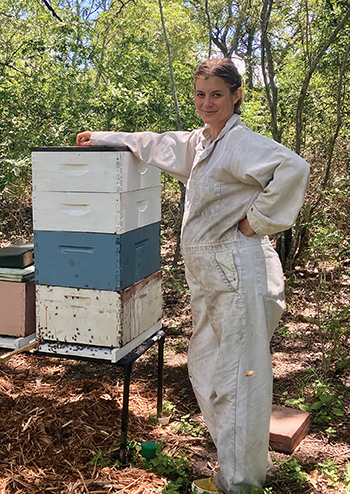
Tara Chapman of Two Hives Honey had already outgrown her maternity overalls at 29 weeks
and took to wearing XXL men’s coveralls for the last few weeks
of pregnancy. “By 39 weeks I could barely zip these up!”
Oregon midwife Jen Holland said she doesn’t necessarily give farmers the standard blanket advice about not lifting and avoiding heavy work, because she realizes farmers realistically have to (and want to) keep working as much as possible for as long as possible. Also, farmers are generally physically fit and already more accustomed to heavier work than many people.
So, instead she works with farmers to focus on body alignment and adjusting to a new center of gravity. “Make sure you put your weight over your heels rather than toes, which ensures that the large muscles at the back of your body (glutes, hamstrings, back muscles) are supporting your body weight, rather than adding strain to the belly and pelvic floor.” She suggests exhaling on the exertion, which also helps shift the load to those bigger muscles and off the pelvic floor. “The focus is on how to support your body while doing your work,” she said.
There are, of course, basic physical limitations with a large belly. Mel Sylvestre of Grounded Acres Organic Farm in British Columbia carried twins, giving her an extra-large challenge. “The John Deer tractor seat was jammed so I couldn’t fit behind the wheel at around seven-months pregnant.” Likewise, Melissa Streng said that she was able to work at the wash sink pretty far into pregnancy, “but had to pass it on during the last month when my belly got in the way.”
In addition to these basic space limitations, Holland, the midwife, said it’s always important for every pregnant person, including physically fit ones, to watch for red flags when doing physical work. Danger signs include pre-term labor, the uterus being more “active” than it should be (i.e., cramping), and bleeding or loss of fluid. “Those are signs to slow down for farmers or not.” She also advises to watch out for any strong pain. “We shouldn’t be in pain. Pain is an indication.”
In my own pregnancy, there was a point when lifting a full harvest tote of kale still felt fine but lifting a full bin of potatoes hurt. So, I learned to ask for help with certain tasks even as I kept working until the end of pregnancy, an experience shared by many farmers. Always listen to your body and always check in with your own care provider about their recommendations based on your health history and pregnancy.
Holland also points out that very physically active people often have tight pelvic muscles, which can create challenges in labor and postpartum healing. She suggests seeking pelvic floor physical therapy during pregnancy for anyone who has experienced any symptoms of hypertonic (tight) pelvic floor muscles. Symptoms include painful sex, pain in the pelvis, history of very painful cramping with periods, or incontinence. “Don’t wait for more problems before getting therapy.”
For all pregnant people, Holland recommends finding moments of awareness during the day to take long, slow belly breaths and become aware of their body and pelvic floor. “Watch for places in your body where you’re clenching, especially the butt or pelvic floor. Work on relaxing all those clenched muscles.”
Holland’s last big piece of pregnancy advice was to stay hydrated. She says the standard recommendation is that pregnant people drink half their weight in ounces during the day; so, a 160 pound person should aim to drink at least 80 ounces of water per day. “On hot days or during periods of heavy exertion, farmers may need to drink more — or to consider adding electrolytes to water — to avoid dehydration.”
Emotional work
Amidst all the body changes, many farmers reported going through a lot of emotional work during pregnancy.
Farmers with more challenging pregnancies that required them to step back from physical work, struggled with their new relationship to the farm, even if it was just a temporary change. Jordan Goldsmith of Moonrose Farm in Massachusetts described her pregnancy as difficult, with lots of early nausea, regular headaches, and body discomfort. “Pregnancy was so much harder on my body than I ever expected.”
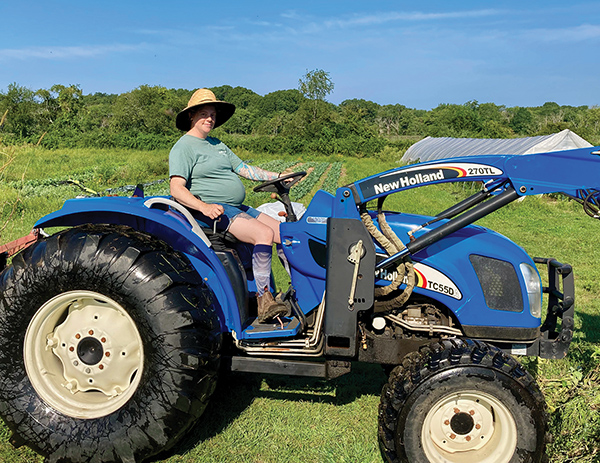
At 33-weeks pregnant, Jordan Goldsmith used the tractor to harrow beds for fall cover crops. She said that she drove the tractor “until I couldn’t turn the wheel anymore because my belly got in the way. It was one of the only tasks I could do to feel useful since I had so many uncomfortable symptoms.”
She said that after about 35 weeks, she didn’t feel very helpful and needed to take afternoons off to nap. In late pregnancy, she sat in a chair in the field to answer questions and give directions, and sometimes the crew would bring her bins of vegetables and flowers to bunch. “I generally consider myself very strong and tough and have a strong work ethic, so it was really challenging to feel weak and to just sit and watch everyone else working without being able to help.” Even though this experience was difficult, Goldsmith advises other pregnant farmers: “Don’t push yourself too hard during pregnancy. It’s not worth it.”
Nicole Sippel of Airy Point Farms in Wisconsin said she worried she wasn’t always taking care of her body the way she should be during pregnancy. She also struggled saying “no” to brides who wanted her to provide flowers for weddings during her planned maternity leave. “Therapy certainly helped me to learn to prioritize self-care and to give myself grace in this season.”
Not only can pregnancy itself affect a farmers’ relationship to their work, there is also the preparation for changing life roles.
“In the beginning, my own cultural biases of what a mom or farmer should be really wore me down,” said Ellen Turner of Little Pond Farm in Florida. “There is a lot of misogyny to explore around the value we put as a society on care-taking, and as female farmers we already experience misogyny in our roles as farmers, too. Things may look different for you than you imagined, your roles and what you can do. Go forward with what you can do and what feels best.”
Heidi Witmer of the LEAF Project Home Farm in Pennsylvania also has advice for pregnant farmers: “Challenge yourself to ask for help. We farmers arrive at this vocation because we are so strong and independent. Matrescence [transition to motherhood] is a powerful time to also get to know your vulnerable sides.”
Parenting and pregnancy
Of course, for some farmers, their current pregnancy isn’t their first, and they are now having to balance the challenges of pregnancy, preparing for birth, farming, and parenting one or more child.
When pregnant with our second child, I remember feeling even more exhausted than I did the first time, because my toddler wasn’t sleeping well. But I also remember feeling less nauseated over all, so there were parts that were easier and also harder. Again, every pregnancy can be unique.
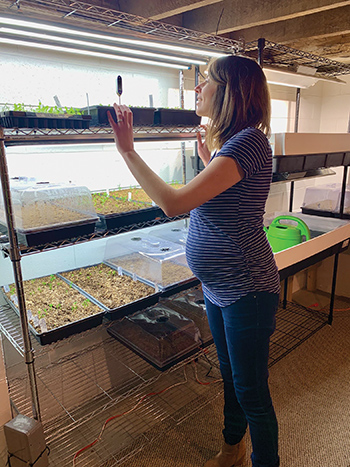 Some farm work is lighter and easier during pregnancy, for example working with starts. Nicole Sippel checked on plant babies in her basement at about 20-weeks pregnant.
Some farm work is lighter and easier during pregnancy, for example working with starts. Nicole Sippel checked on plant babies in her basement at about 20-weeks pregnant.
Turquoise Connelly of Global Native Farms in Ohio is expecting their second child now and agrees that managing a toddler’s sleep habits adds a whole new element on top of their existing load of farming and working off-farm. But they also say that having their child with them brings a new level of inspiration to the farm work. “It’s been fun and pretty amazing to have her out there with me feeding and watering the chickens, trying her best to help Dad and I collect berries.”
For more on balancing farming with parenting, please also check out the February 2022 GFM article I wrote, “Strategies for balancing parenting and farm work.”
Good for pregnancy
For the bulk of this article, I’ve addressed how pregnancy affects farmers and their work, but our work as farmers can also affect our pregnancies, including positive ways. Plenty of farmers reported hard experiences during pregnancy, including miscarriages and birth-related injuries. So being a farmer doesn’t necessarily protect against the normal range of challenging pregnancy and birth outcomes. But there are potential positives.
Holland said that she sees huge lifestyle benefits for pregnant farmers. “Our bodies are designed to move, and farmers are moving,” she said. “People in modern culture don’t move as much as our ancestors did, and daily movement on the farm is so important for pelvic mobility and fetal positioning.” She also says that access to good quality food is very important during pregnancy and she works with all her pregnant clients to support their pregnancies with nutrition, something she observes comes easily to people living on farms and growing abundant fresh food.
Victoria shared these positive sentiments. “I believe that being a farmer is part of what allowed me to have a healthy pregnancy and home birth at age 40,” she said. “Every time I fed my body with the food that we grow while I was pregnant I thought about how it was becoming my baby. I love that.”
On the flip side, are there elements of the pregnancy and birth experience that are more challenging for farmers? Holland had a quick answer. Farmers almost always need strong encouragement to take real extended rest after giving birth. I’ll address that in my next article about birth and postpartum healing for the farmer.
Katie Kulla lives and farms with her family in Yamhill County, Oregon. You can find Katie at KatieKulla.com and on Instagram: @katiekulla.

.png)
